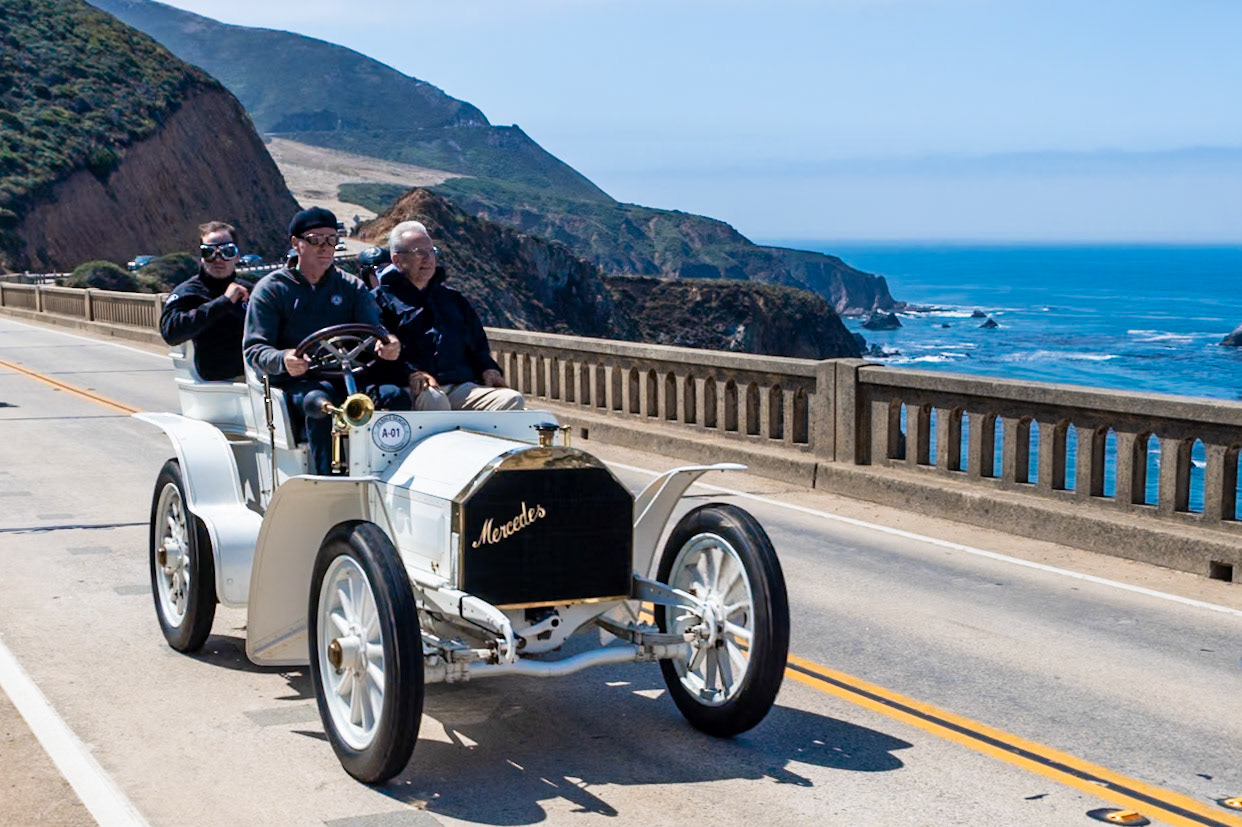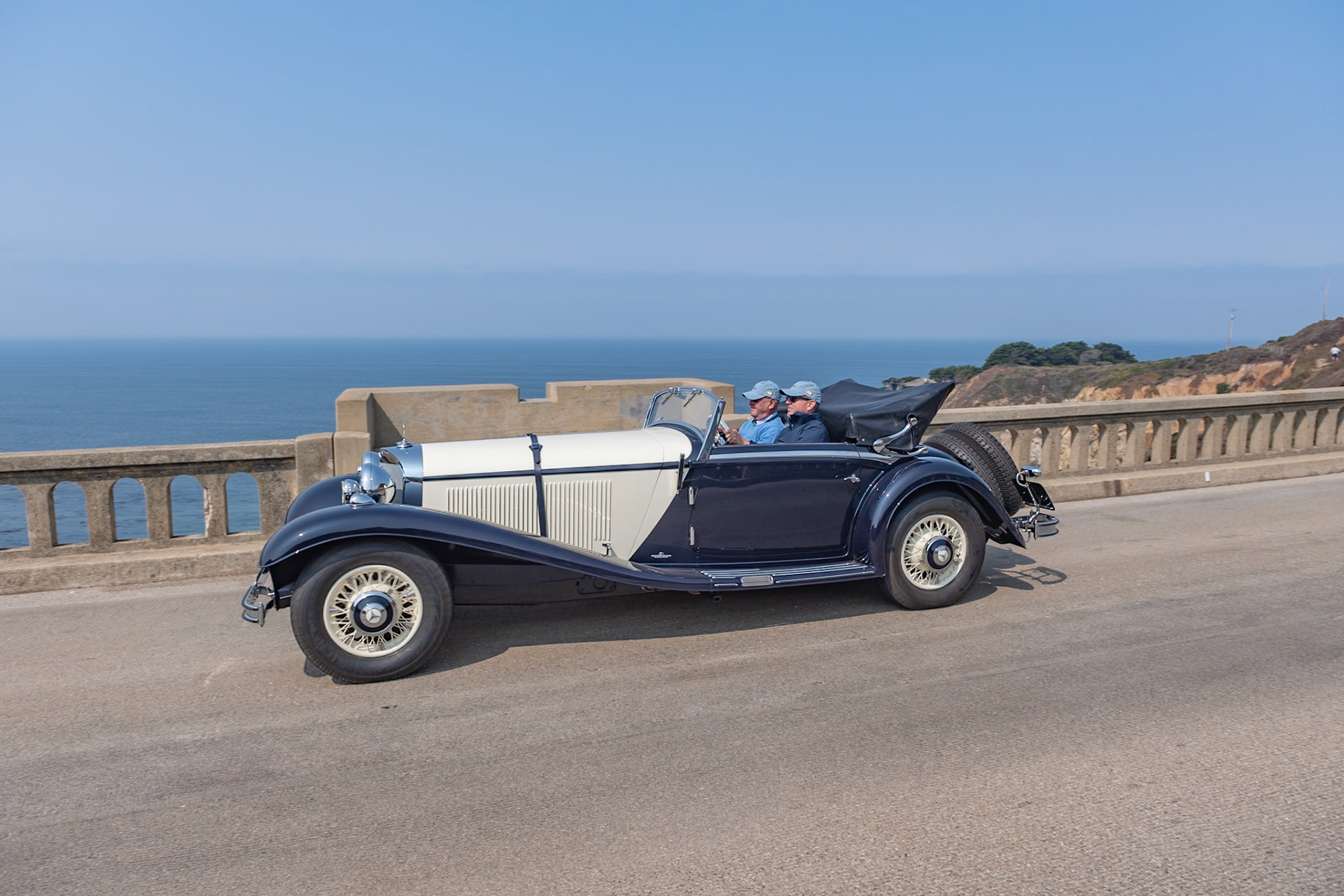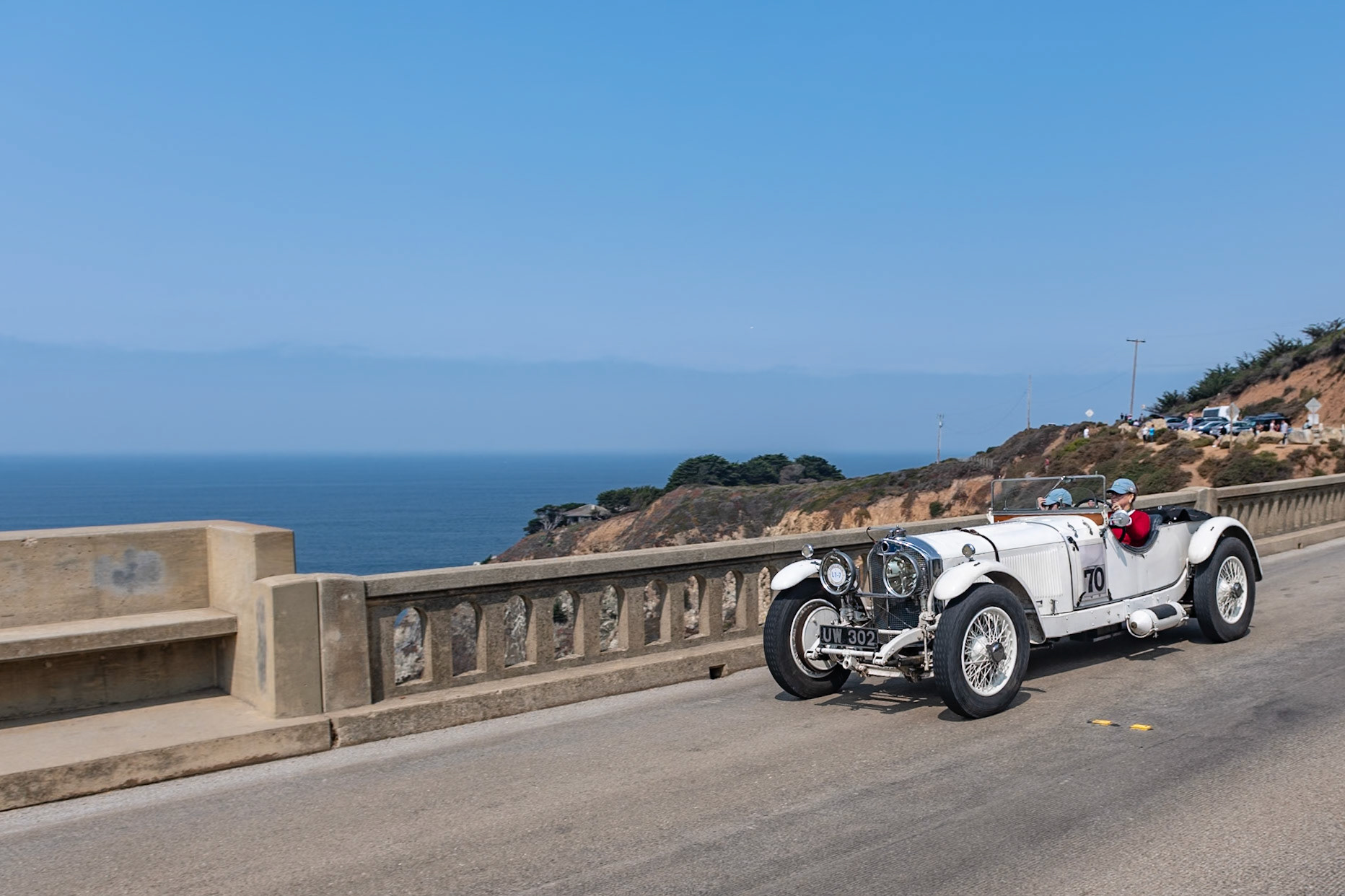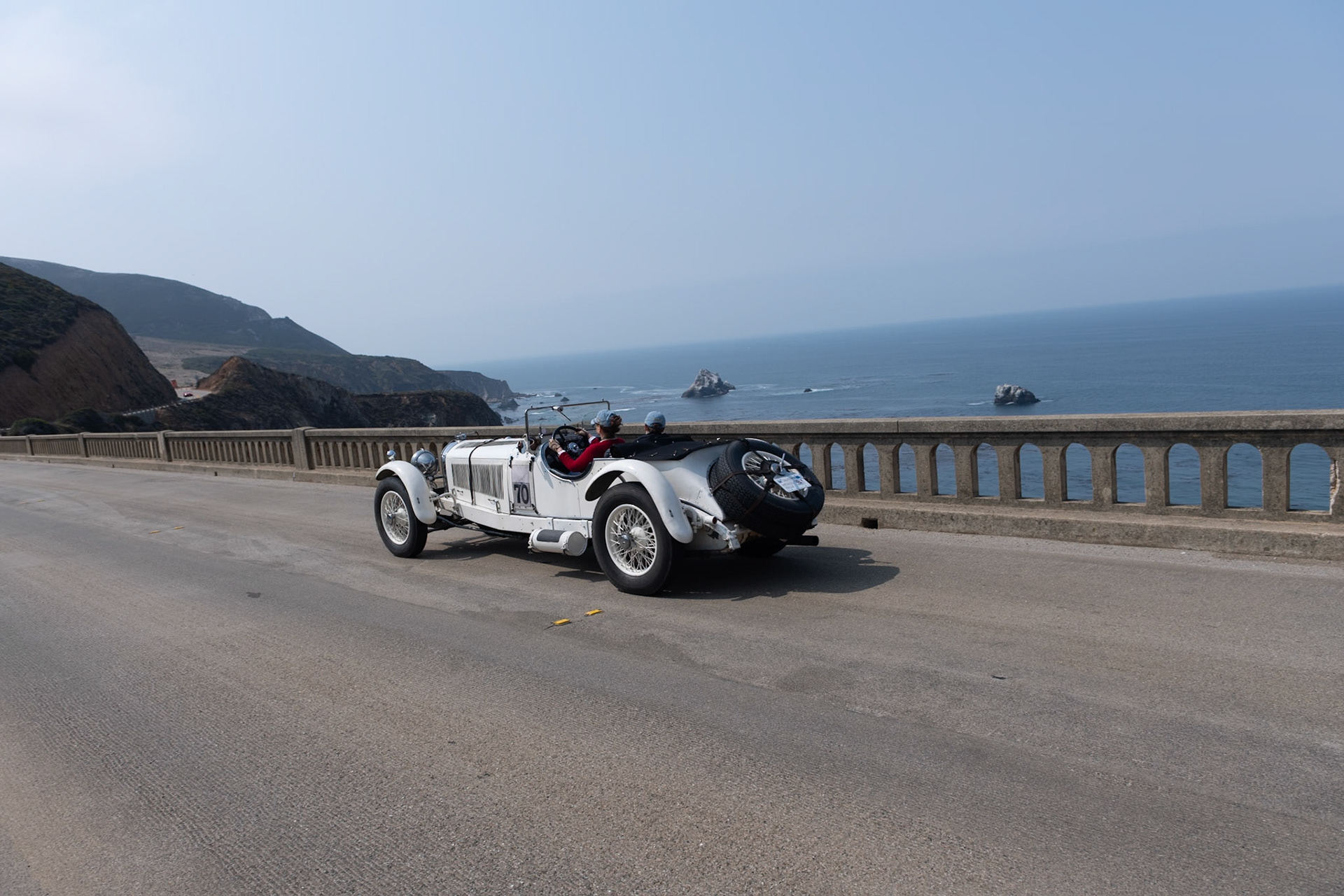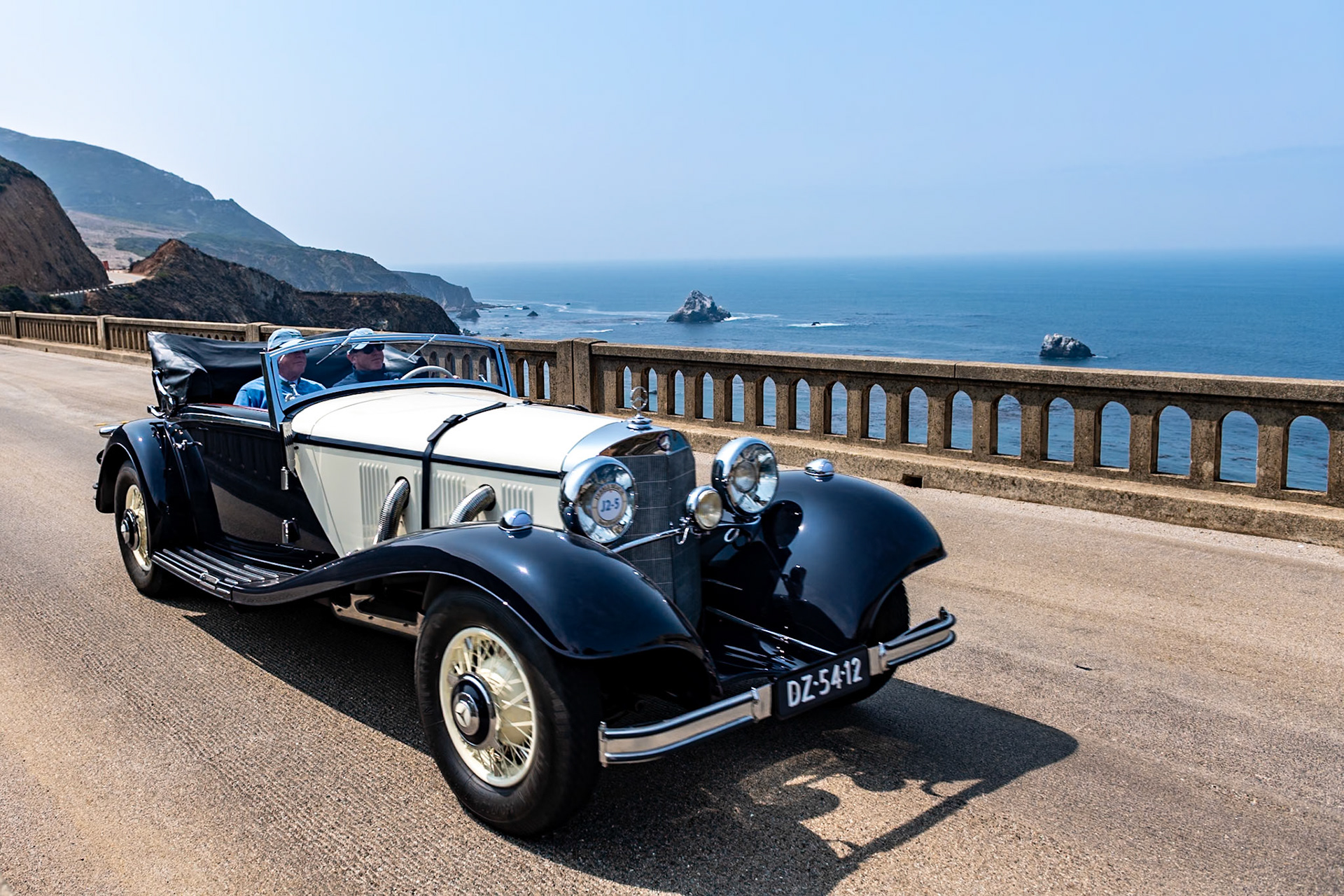
In the late 1950s Mercedes-Benz decided to introduce an open two-seat roadster to sit alongside their 300 SL Gullwing Coupes. US importer Max Hoffman is often quoted as the father of this Roadster because he saw a great opportunity to sell an open version of the 300 SL in America. The Roadster chassis was almost identical to that of the Coupe, but it had an improved suspension, it handled far better and, far more importantly, it was a lot cooler. A total of 1,853 Roadsters were built between 1957 and 1963. This example was restored at Mercedes-Benz Classic Center; it was refinished in its original paint color, DB 166 Blue-Gray, and the original seats were refurbished with original Mercedes-Benz leather. All of the car’s components are original and have matching numbers.

This Mercedes-Benz 300 SL Gullwing (chassis 4500120) was completed in December 1954, four months into production of the 300 SL. It was owned by two motor racing greats: George Tilp, who managed the Mercedes factory racing cars from 1955 to 1958, and Jim Hall, the Chaparral Can-Am winning constructor who pioneered aerodynamics in motorsport. The Gullwing was the first of three raced by Tilp, and these cars won the 1955, 1956, and 1957 SCCA class D championships. Jim Hall bought the car in 1958 and drove it from New Jersey to Carroll Shelby’s workshop in Texas, where he had the car painted in the candy apple red lacquer that it still wears today. He also re-did the interior in tan leather and installed an air conditioning system to tackle the Texas climate. In 1965, Hall placed his cherished Gullwing in storage where it remained until 2016.

Introduced at the 1957 Geneva Motor Show, the Mercedes-Benz 300 SL Roadster was a completely re-engineered open-topped stablemate for the original 300 SL Gullwing Coupe. The 3.0-liter straight-6 fuel-injected engine remained but was boosted from 215 bhp to 225 bhp, and the chassis was redesigned with lower sills and more strength. The Roadster remained in production until early 1963, by which time 1,858 had been built. This 300 SL Roadster was purchased in Oslo, Norway, and delivered to its first owner, C. Jewett Henry of Pennsylvania, who drove it very rarely before his death in 1979. The car was later put into storage by Henry’s son. The Roadster with matching hardtop was acquired by its current owner in 2016.

The Mercedes Simplex 40 HP was launched in March 1902. The suffix “Simplex” was intended to indicate how easy the new model was to drive. The previous model, the Mercedes 35 HP, marked the end of the carriage style that had dominated the industry; the 40 HP is now considered to be the first modern motorcar, especially in the world of motorsport. The pioneering British racer, E. T. Stead drove a 40 HP to first place in the 1902 La Turbie Hillclimb near Nice, reaching speeds of more than 60 mph and beating Georges Lemaitre and Wilhelm Werner, who were driving similar models. This car, delivered to its first owner in March 1903, is one of the oldest Mercedes in the world. It has taken part in the London to Brighton Veteran Car Run on several occasions.

The Mercedes-Benz S and SS models were among the top luxury cars in the late 1920s and many were bodied by the best coachbuilders of the day. Carrozzeria Castagna was a popular choice for wealthy Europeans who wanted a car with bodywork that was beautiful yet understated. This particular Mercedes-Benz SS Castagna Tourer has simple lines on the exterior but a very luxurious interior. The car appears to be at speed even when at rest, due to the rakish slant of the front doors and the rear section of bodywork—and this perception is further accentuated by the length of the hood. The car is believed to have been owned at one time by the jazz singer Al Jolson. It has been in The Keller Collection since 1980, and it won its class at Pebble Beach in 1989.

The 300 S, the first postwar prestige car built by Mercedes-Benz, made its debut at the Paris Auto Salon in 1951. By 1957, the 300 SC was the top of the range, a luxurious Grand Tourer in the best tradition of the prewar 540K. The 300 range included a two-seat roadster Saloon and a Cabriolet, but the more powerful 300 SC Coupe was introduced at the Frankfurt Motor Show in 1955. A total of 98 of these Coupes were produced by Sindelfingen, the factory coachwork division for Mercedes. The 300 SC cost more than double the price of the most expensive Cadillac at the time. It was even more expensive than its stablemate, the 300 SL Gullwing. Consequently, this 300 SC Coupe with its factory-installed sunroof is one of only nine sold in the United States.

This Mercedes-Benz 300 SL Gullwing (chassis 4500120) was completed in December 1954, four months into production of the 300 SL. It was owned by two motor racing greats: George Tilp, who managed the Mercedes factory racing cars from 1955 to 1958, and Jim Hall, the Chaparral Can-Am winning constructor who pioneered aerodynamics in motorsport. The Gullwing was the first of three raced by Tilp, and these cars won the 1955, 1956, and 1957 SCCA class D championships. Jim Hall bought the car in 1958 and drove it from New Jersey to Carroll Shelby’s workshop in Texas, where he had the car painted in the candy apple red lacquer that it still wears today. He also re-did the interior in tan leather and installed an air conditioning system to tackle the Texas climate. In 1965, Hall placed his cherished Gullwing in storage where it remained until 2016.

Introduced at the 1957 Geneva Motor Show, the Mercedes-Benz 300 SL Roadster was a completely re-engineered open-topped stablemate for the original 300 SL Gullwing Coupe. The 3.0-liter straight-6 fuel-injected engine remained but was boosted from 215 bhp to 225 bhp, and the chassis was redesigned with lower sills and more strength. The Roadster remained in production until early 1963, by which time 1,858 had been built. This 300 SL Roadster was purchased in Oslo, Norway, and delivered to its first owner, C. Jewett Henry of Pennsylvania, who drove it very rarely before his death in 1979. The car was later put into storage by Henry’s son. The Roadster with matching hardtop was acquired by its current owner in 2016.

Frans van Haren Antwerpen, Belgium and Mrs. Leony Hendricks Druten, The Netherlands

The Mercedes-Benz S and SS models were among the top luxury cars in the late 1920s and many were bodied by the best coachbuilders of the day. Carrozzeria Castagna was a popular choice for wealthy Europeans who wanted a car with bodywork that was beautiful yet understated. This particular Mercedes-Benz SS Castagna Tourer has simple lines on the exterior but a very luxurious interior. The car appears to be at speed even when at rest, due to the rakish slant of the front doors and the rear section of bodywork—and this perception is further accentuated by the length of the hood. The car is believed to have been owned at one time by the jazz singer Al Jolson. It has been in The Keller Collection since 1980, and it won its class at Pebble Beach in 1989.

The Mercedes Simplex 40 HP was launched in March 1902. The suffix “Simplex” was intended to indicate how easy the new model was to drive. The previous model, the Mercedes 35 HP, marked the end of the carriage style that had dominated the industry; the 40 HP is now considered to be the first modern motorcar, especially in the world of motorsport. The pioneering British racer, E. T. Stead drove a 40 HP to first place in the 1902 La Turbie Hillclimb near Nice, reaching speeds of more than 60 mph and beating Georges Lemaitre and Wilhelm Werner, who were driving similar models. This car, delivered to its first owner in March 1903, is one of the oldest Mercedes in the world. It has taken part in the London to Brighton Veteran Car Run on several occasions.

The 300 S, the first postwar prestige car built by Mercedes-Benz, made its debut at the Paris Auto Salon in 1951. By 1957, the 300 SC was the top of the range, a luxurious Grand Tourer in the best tradition of the prewar 540K. The 300 range included a two-seat roadster Saloon and a Cabriolet, but the more powerful 300 SC Coupe was introduced at the Frankfurt Motor Show in 1955. A total of 98 of these Coupes were produced by Sindelfingen, the factory coachwork division for Mercedes. The 300 SC cost more than double the price of the most expensive Cadillac at the time. It was even more expensive than its stablemate, the 300 SL Gullwing. Consequently, this 300 SC Coupe with its factory-installed sunroof is one of only nine sold in the United States.

Frans van Haren Antwerpen, Belgium and Mrs. Leony Hendricks Druten, The Netherlands

After the union of Daimler and Benz in 1926 the first model to be built was the Model 630K, officially designated the 24/100/140. The 24 refers to the taxable horsepower, the 100 is the actual horsepower, and the 140 is the horsepower with the supercharger engaged. This car (chassis 32019) was delivered to the Mercedes-Benz dealership in London then dispatched to Brighton-based Thomas Harrington to be fitted with this sporting coachwork. The car spent about five decades in the United Kingdom, then went to a collector in Thailand, where it was later seized by Customs and spent many years in storage until a prominent Thai family purchased it. In 1999 the car was sold and delivered to the Mercedes-Benz Classic Center in Irvine, California, for a full service, safety check and road test. It remains largely original except for minor restoration work.

1936 Mercedes-Benz 500K Special Roadster

The 5.4-liter Mercedes-Benz 540K was introduced in 1936. The chassis for both the 500 and 540K models were designed to accommodate a variety of different body styles and were available in three different lengths. This sporty Cabriolet A, built at Mercedes’ own Sindelfingen coachworks, is similar to that of the exclusive 540K Roadster and is among the most sought after of all factory coachwork. It has had only two owners from new. The previous French owner, Monsieur Franchi, was the founder of the prestigious Parisian Nightclub “La Roulette,” which hosted artists like Édith Piaf, Charles Aznavour and Django Reinhardt.

The 5.4-liter Mercedes-Benz 540K was introduced in 1936. The chassis for both the 500 and 540K models were designed to accommodate a variety of different body styles and were available in three different lengths. This sporty Cabriolet A, built at Mercedes’ own Sindelfingen coachworks, is similar to that of the exclusive 540K Roadster and is among the most sought after of all factory coachwork. It has had only two owners from new. The previous French owner, Monsieur Franchi, was the founder of the prestigious Parisian Nightclub “La Roulette,” which hosted artists like Édith Piaf, Charles Aznavour and Django Reinhardt.

The 5.4-liter Mercedes-Benz 540K was introduced in 1936. The chassis for both the 500 and 540K models were designed to accommodate a variety of different body styles and were available in three different lengths. This sporty Cabriolet A, built at Mercedes’ own Sindelfingen coachworks, is similar to that of the exclusive 540K Roadster and is among the most sought after of all factory coachwork. It has had only two owners from new. The previous French owner, Monsieur Franchi, was the founder of the prestigious Parisian Nightclub “La Roulette,” which hosted artists like Édith Piaf, Charles Aznavour and Django Reinhardt.

Prior to the official introduction of the 540K, Mercedes-Benz produced thirteen cars which were classified as 500Ks, but actually built with the new 5.4-liter motor, and which are commonly referred to as “pre-production” cars. Only three of those thirteen are believed to survive. This example, a Cabriolet A, marries the sporty rear-end styling of the 500K with the elegant front end features of the 540K. It was delivered new to Vogel Verlag, a publisher in Possneck-Thuringen and later found its way to North Africa. It was abandoned in the desert and discovered by General Walter B. Smith who brought to the United States in 1945. After changing hands several times, the current owner acquired the car in 1999.

Prior to the official introduction of the 540K, Mercedes-Benz produced thirteen cars which were classified as 500Ks, but actually built with the new 5.4-liter motor, and which are commonly referred to as “pre-production” cars. Only three of those thirteen are believed to survive. This example, a Cabriolet A, marries the sporty rear-end styling of the 500K with the elegant front end features of the 540K. It was delivered new to Vogel Verlag, a publisher in Possneck-Thuringen and later found its way to North Africa. It was abandoned in the desert and discovered by General Walter B. Smith who brought to the United States in 1945. After changing hands several times, the current owner acquired the car in 1999.

Prior to the official introduction of the 540K, Mercedes-Benz produced thirteen cars which were classified as 500Ks, but actually built with the new 5.4-liter motor, and which are commonly referred to as “pre-production” cars. Only three of those thirteen are believed to survive. This example, a Cabriolet A, marries the sporty rear-end styling of the 500K with the elegant front end features of the 540K. It was delivered new to Vogel Verlag, a publisher in Possneck-Thuringen and later found its way to North Africa. It was abandoned in the desert and discovered by General Walter B. Smith who brought to the United States in 1945. After changing hands several times, the current owner acquired the car in 1999.

In mid-1928 a new version of the Mercedes-Benz S was produced, designated as the SS or Super Sport. Intended as a grand tourer, the SS used the 6-cylinder engine from the Type 630, but it was bored out to 7.1 liters, providing an additional 40 horsepower. With the supercharger engaged, the SS could produce 200 bhp. The car was so powerful that it easily beat almost all the cars of its era and could achieve a top speed well in excess of 118 mph. This car was originally built for Rudolf Caracciola for the 1929 Ulster Tourist Trophy race held on the Ards road circuit in Ireland. Caracciola went on the win that race and then later drove this car in the 1930 Irish Grand Prix, the 1931 German Grand Prix, and the 1931 Mille Miglia. The car was then purchased by Earl Francis Howe, who raced it in the United Kingdom, earning five first-place finishes. This car retains all of the original components and drivetrain and is in very original condition.

In mid-1928 a new version of the Mercedes-Benz S was produced, designated as the SS or Super Sport. Intended as a grand tourer, the SS used the 6-cylinder engine from the Type 630, but it was bored out to 7.1 liters, providing an additional 40 horsepower. With the supercharger engaged, the SS could produce 200 bhp. The car was so powerful that it easily beat almost all the cars of its era and could achieve a top speed well in excess of 118 mph. This car was originally built for Rudolf Caracciola for the 1929 Ulster Tourist Trophy race held on the Ards road circuit in Ireland. Caracciola went on the win that race and then later drove this car in the 1930 Irish Grand Prix, the 1931 German Grand Prix, and the 1931 Mille Miglia. The car was then purchased by Earl Francis Howe, who raced it in the United Kingdom, earning five first-place finishes. This car retains all of the original components and drivetrain and is in very original condition.

In mid-1928 a new version of the Mercedes-Benz S was produced, designated as the SS or Super Sport. Intended as a grand tourer, the SS used the 6-cylinder engine from the Type 630, but it was bored out to 7.1 liters, providing an additional 40 horsepower. With the supercharger engaged, the SS could produce 200 bhp. The car was so powerful that it easily beat almost all the cars of its era and could achieve a top speed well in excess of 118 mph. This car was originally built for Rudolf Caracciola for the 1929 Ulster Tourist Trophy race held on the Ards road circuit in Ireland. Caracciola went on the win that race and then later drove this car in the 1930 Irish Grand Prix, the 1931 German Grand Prix, and the 1931 Mille Miglia. The car was then purchased by Earl Francis Howe, who raced it in the United Kingdom, earning five first-place finishes. This car retains all of the original components and drivetrain and is in very original condition.

The 5.4-liter Mercedes-Benz 540K was introduced in 1936. The chassis for both the 500 and 540K models were designed to accommodate a variety of different body styles and were available in three different lengths. This sporty Cabriolet A, built at Mercedes’ own Sindelfingen coachworks, is similar to that of the exclusive 540K Roadster and is among the most sought after of all factory coachwork. It has had only two owners from new. The previous French owner, Monsieur Franchi, was the founder of the prestigious Parisian Nightclub “La Roulette,” which hosted artists like Édith Piaf, Charles Aznavour and Django Reinhardt.

In mid-1928 a new version of the Mercedes-Benz S was produced, designated as the SS or Super Sport. Intended as a grand tourer, the SS used the 6-cylinder engine from the Type 630, but it was bored out to 7.1 liters, providing an additional 40 horsepower. With the supercharger engaged, the SS could produce 200 bhp. The car was so powerful that it easily beat almost all the cars of its era and could achieve a top speed well in excess of 118 mph. This car was originally built for Rudolf Caracciola for the 1929 Ulster Tourist Trophy race held on the Ards road circuit in Ireland. Caracciola went on the win that race and then later drove this car in the 1930 Irish Grand Prix, the 1931 German Grand Prix, and the 1931 Mille Miglia. The car was then purchased by Earl Francis Howe, who raced it in the United Kingdom, earning five first-place finishes. This car retains all of the original components and drivetrain and is in very original condition.










